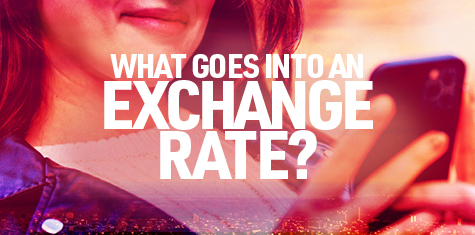
April 8, 2025 • News and Promotions~MoneyGram in the News

A fundamental part of world commerce and finance, exchange rates determine the value of one currency for conversion to another.
In this blog, we’ll dive into exchange rates and how they work.
There are two types of exchange rates in the marketplace: fixed and free-floating.
A fixed exchange rate is when a central bank or government ties a country’s currency to another country’s currency or commodity. Many currencies are pegged to the euro or US dollar. For example, the Danish krone is often pegged to the euro.
If a country is rich in natural resources like precious metals, crops and oil, its currency will often fluctuate with its value. These are usually referred to as commodity currencies.
On the other hand, free-floating exchange rates aren’t tied to a government – but to the greater marketplace. Variables like supply, demand, speculation and the strength of respective currencies determine exchange rates.
Due to the volatility and decentralization of the free-floating market, exchange rates can change in as little as a second, regardless of the time.
Let’s say you want to transfer money from the United States to Mexico. If you transfer $100, and the exchange rate is 1 US Dollar (USD) for 21 Mexican Pesos (MXN), the receiver would get 2,100 MXN.
Suppose you send currency from a country with a strong economy, higher interest rates and/or political stability. In that case, this will often lead to favorable exchange rates – meaning the country’s currency will go farther in a country that may not have the same conditions.
On the flip side, if a country’s currency is weaker relative to other currencies, imports become more expensive, and exports become cheaper. This constitutes an unfavorable exchange rate.
No, not every remittance provider offers the same exchange rate. Foreign exchange service providers make money by buying and selling currency according to bid and ask prices.
Each entity asks for different bid (what they will pay for a currency) and ask price (what they will sell a currency for). The difference in price is called the spread. Due to this, exchange rates will vary depending on what each entity wants their spread to be.
An example is at airport currency exchanges. When you arrive at your destination’s airport with cash from your home country, these exchanges are ready to convert your cash, but with typically higher markups due to the convenience factor.
With MoneyGram, sending money with great exchange rates* is fast and easy.
You can see real-time exchange rates to over 200 countries and territories in the MoneyGram® app or our website in a few taps or clicks.
Need to send money directly to your friends and family? With around-the-clock service to bank accounts, mobile wallets, debit cards and for cash pickup at approximately 450,000 locations worldwide, receiving money is reliable and convenient.
Make sure your loved ones get more of what you send today.
*MoneyGram makes money from currency exchange.